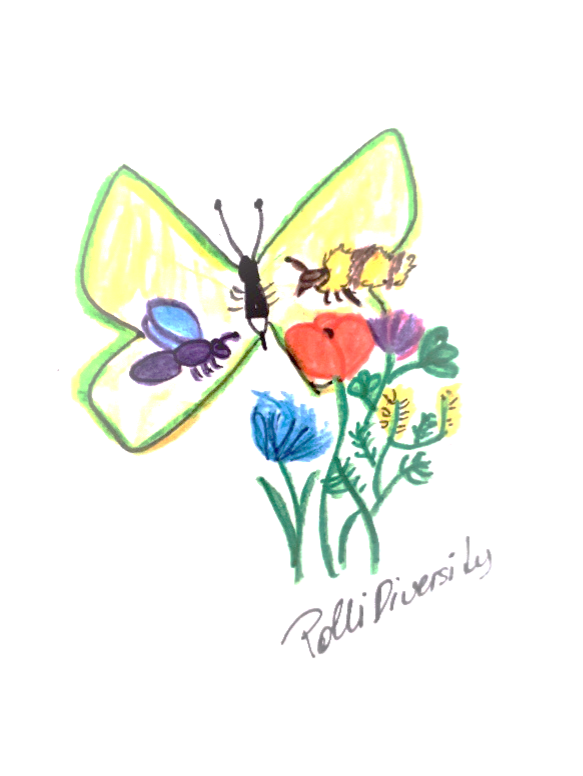
Stabstelle für Akquisition
8952 Irdning-Donnersbachtal
PolliDiversity 2.0
Compared to PolliDiversity, PolliDiversity 2.0. is still about creating habitats for insects, but the tasks of the citizen scientists have changed somewhat due to usability. The project was offered for the first time at the Citizen Science Award in 2021. In 2022, the second round took place in a modified form. Due to career changes of the project participants, the project will not be offered in 2023, but further project runs are planned for the future.
The aim of PolliDiversity 2.0. is to get as many people as possible excited about biodiversity and pollinators in their environment. Through active participation in research, the intrinsic motivation to actively engage in biodiversity conservation can be promoted. The goal of the citizen scientists will be to document the phenological development of plant species and then observe which pollinators visit these areas and at what time.
What are the tasks of the participating citizen scientists?
The main task of the citizen scientists is to document how the different plant species in the ReNatura wildflower mixture Gumpensteiner BW3 develop phenologically. Another task will be to observe the pollinators that visit the flowering areas. The resulting data will on the one hand provide interesting insights into the plant species in the flowering mixture and on the other hand valuable contributions to research into the lifestyles of the pollinators.
Documentation of phenological development
For the documentation of the phenological development of the flowering areas, a template is handed out to the citizen scientists to be completed for the documentation. The time of sowing, budding, flowering and plant growth should be documented. Different parameters such as outdoor temperature, weather and altitude are also included.
Observation of pollinators and data collection
When observing pollinators, the focus should be on wild bees in particular. Participants will also be given a simple identification key to assist them. Data collection is done via the platform of the Austrian Nature Conservation Union www.naturbeobachtung.at. There is a separate comment function where the project "PolliDiversity 2.0" is to be indicated.
Planting the flowering area
Citizen scientists receive seeds of the ReNatura wildflower mixture Gumpensteiner BW3 for an area of approx. 5 m². The seeds can be sown in your own garden or optionally in pots, which is why it is also possible to participate without having your own garden. The following plant species are sown:
Yarrow (Achillea millefolium), Field chamomile (Anthemis arvensis), Dyer's chamomile (Anthemis tinctoria), Kidney vetch (Anthyllis vulneraria), common marigold (Calendula officinalis), Caraway (Carum carvi), Cornflower (Centaurea cyanus), Brown Knapweed (Centaurea jacea), Centaurea pseudophrygia, Scabiosa (Centaurea scabiosa), Common Chicory (Cichorium intybus), Meadow Buttercup (Crepis biennis), Wild Carrot (Daucus carota), Carthusian Carinthia (Dianthus carthusianorum), Viper's Head (Echium vulgare), Widow's-flower (Knautia arvensis), Dandelion (Leontodon hispidus), Marguerite (Leucanthemum vulgare), Kidney Clover (Lotus corniculatus), Chamomile (Matricaria chamomilla), Yellow Clover (Medicago lupulina), White Sweetclover (Melilotus albus), Sweet Yellow Clover (Melilotus officinalis), Evening Primrose (Oenothera biennis), Sainfoin (Onobrychis viciifolia), Corn Poppy (Papaver rhoeas), meadow sage (Salvia pratensis), red campion (Silene dioica), common glue (Silene vulgaris), hare clover (Trifolium arvense), field clover (Trifolium campestre), small clover (Trifolium dubium), red clover (Trifolium pratense), black mullein (Verbascum nigrum), Sticky Catchfly (Silene viscaria) - all certified according to G-Zert®.
In the best case, the flowering area should be established as early as March (as soon as the first early flowering plants become visible), but by the end of April at the latest.
Which materials will be made available to the participating citizen scientists?
In order to enable citizen scientists to identify and participate in the project, the following information materials will be prepared and made available in digital form:
- Info workshop on Zoom
- Digital materials for participants: Experiment instructions, information materials on pollinators and identification keys for the selected pollinators.
- Template for the documentation of phenological development
The project materials are only available in German.
Further details on the project
The task of the citizen scientists is to document how the flowering areas develop: When do the seeds emerge? What is the temperature? What was the weather like in the past weeks? How tall are the plants after another two weeks? When do the first plants start to flower? If no plants come up, what could be the reason - have birds or snails been seen?
Furthermore, the citizen scientists should determine on several days from May to the end of July (depending on the flowering time of the plants) which plant species is preferred as a food source by certain wild bee species and other pollinators. Monitoring should be carried out on as many days as possible at three different times of day during daylight hours. The weather also plays a role, as wild bees are more likely to be seen in sunny weather but less likely to be seen in rain or strong winds.
How will the data of the participating citizen scientists be handled?
The data will be treated strictly confidentially and in accordance with the EU General Data Protection Regulation.
How can interested parties register?
Interested parties are welcome to register by e-mail. Please send registrations and queries to: This email address is being protected from spambots. You need JavaScript enabled to view it.
Citizen Science Seminar
In 2021, poject coordinator Verena Mayer held a lecture about "PolliDiversity" as part of the lecture series "Citizen Science Seminar" at the University of Natural Resources and Life Sciences Vienna (BOKU): "'PolliDiversity' - pollinator diversity in your own environment" (in German).
Project coordination:
Mag. Verena Mayer
Dipl. Ing. Renate Mayer
Other contributors:
Dr. Wilhelm Graiss
This project fulfilled version 1.1 of the quality criteria for citizen science projects on Österreich forscht.
- plants
- animals

